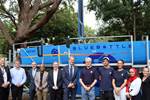Australian partners to develop, validate laser cladding system for MMC coatings
ACM CRC, LaserBond and The University of Sydney aim to strengthen Australia’s manufacturing capabilities through monitoring, prototype assessment and simulation of the coating process for metal matrix composite (MMC) materials.
LaserBond, The University of Sydney and the ACM CRC team pose in front of LaserBond’s Sydney head office in Smeaton Grange. Source | ACM CRC
The Australian Composites Manufacturing Cooperative Research Centre (ACM CRC, New South Wales, Australia) has announced a new project that aims to develop a high-efficiency, fully automated laser cladding system that will be used to design and create multifunctional metal matrix composite (MMC) coatings for industries like marine, mining and defense, to name a few.
MMC, a composite material with fibers or particles dispersed in a metallic (copper, aluminum or steel) matrix, is said to be a critical asset to Australia, ACM-CRC reports, as sourcing replacement parts for machinery overseas results in long lead times. Moreover, use of laser cladding to repair worn or corroded parts reduces downtime and creates value locally. The same process can also be used to produce new parts, enhancing efficiency and supporting local manufacturing.
Dr Steve Gower, ACM CRC CEO, highlights the broader economic impact of the project: “Corrosion, exacerbated by climate change, costs countries 3-4% of their GDP,” Gower explains. “The demand for environmentally friendly and economical processes to produce high-quality coatings is growing. Understanding corrosion mechanisms in MMC coatings is essential to developing wear and corrosion-resistant solutions, which requires expert knowledge and specialized testing. Our project brings together this expertise to support manufacturers and policymakers in optimizing resources, reducing waste and creating more sustainable products.”
The project will examine the effects of different process parameters on the microstructure, hardness, wear resistance and corrosion resistance of laser composite coatings. While cost-effective construction steels are commonly used for surface coatings, the proposed laser cladding technology is said to offer an alternative, providing surface treatments that significantly improve the durability and performance of parts. This technology has already been successfully applied in industries such as aviation, automotive, marine, mining, gas and oil, extending the lifespan of equipment and reducing the need for new production.
ACM CRC and its partners, LaserBond (Grange, Australia) and The University of Sydney, will develop an automated, high-efficiency laser cladding process and an in-house catalog of materials and process parameters. This will serve as a comprehensive guide for using laser cladding to create high-wear, corrosion-resistant coatings.
The project combines process manufacturing optimization, characterization and simulation to address challenges and bottlenecks in automating the process. The goal is to create a fully integrated, automated laser cladding system — operating without harmful chemicals or noise emissions — for LaserBond coatings designed for extreme environments.
Prof. Anna Paradowska, co-lead chief investigator and conjoint professor at The University of Sydney’s School of Civil and Aerospace Engineering, notes the importance of precise control over process parameters, such as laser power and scanning speed, in achieving the desired coating properties. “Systematic studies are still needed to understand the time-related properties of MMC coatings,” she says, “like wear and corrosion resistance, which are critical for industrial applications.”
For more information or to express interest in the project, contact ACM CRC.
Related Content
-
Belzona composite wrap restores corroded carbon steel pipeline
Two-part epoxy paste, epoxy structural adhesive, composite wrap and anti-corrosion coating prevent environmental and economic loss for customer.
-
R&D focus underpins quality gelcoat offerings
CAMX 2024: HK Research strives for innovation and customer satisfaction through meticulously produced polymers, liquid pigments and specialty additives and customer support.
-
Solar-powered photonic cooling enables energy-saving coating
Passive cooling technology can reduce interior temperatures 5-13°C, offering weight, cost and CO2 benefits for cars, construction, aircraft and more.

















